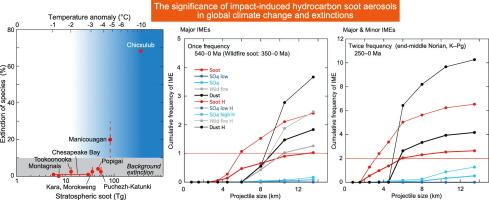The significance of impact-induced hydrocarbon soot aerosols in global climate change and extinctions
IF 2.7
2区 地球科学
Q2 GEOGRAPHY, PHYSICAL
Palaeogeography, Palaeoclimatology, Palaeoecology
Pub Date : 2025-08-30
DOI:10.1016/j.palaeo.2025.113237
引用次数: 0
Abstract
Large meteoroid impacts have punctuated the Phanerozoic Eon, with the Cretaceous–Paleogene (K–Pg) impact as the most prominent example. While some impacts triggered global climate change and mass extinctions, others produced only limited environmental effects. These events injected aerosols into the stratosphere, reducing sunlight, cooling the climate, and decreasing precipitation. Major aerosol types include sulfuric acid (from sulfur-rich rocks), soot (from organic-rich target rocks and wildfires), and dust (from pulverized rock), though their relative roles remain uncertain. Here we quantify the production of each aerosol type and calculate surface temperature anomalies for the nine largest impact craters of the past 250 Myr using target rock lithologies and climate model outputs. Our cross-plot analysis of temperature and extinction magnitude reveals that soot generated from organic carbon in target rocks is likely the primary driver of impact-induced mass extinctions. Additionally, we estimated the frequencies of impact-generated mass extinctions for each aerosol type using two cases: one major extinction (>60 % species loss) in 540 million years (K-Pg) and two major-moderate extinctions (>20 % species loss) in 250 million years (K-Pg and mid Norian). Our findings demonstrate that soot formed from sedimentary rocks most accurately matches the observed frequencies—one major and two minor-major extinctions. These results establish that the severity of cooling and extinction triggered by meteoroid impacts is primarily determined by the abundance of buried organic carbon in the target rocks, underscoring the target sensitivity of impact-induced climate effects.

撞击引起的碳氢烟气溶胶在全球气候变化和物种灭绝中的意义
在显生宙,大型流星体撞击不时出现,白垩纪-古近纪(K-Pg)撞击是最突出的例子。虽然一些影响引发了全球气候变化和大规模物种灭绝,但其他影响只产生有限的环境影响。这些事件将气溶胶注入平流层,减少了阳光,使气候变冷,并减少了降水。主要的气溶胶类型包括硫酸(来自富硫岩石)、烟灰(来自富有机物目标岩石和野火)和灰尘(来自岩石粉状物),尽管它们的相对作用仍不确定。在这里,我们量化了每一种气溶胶类型的产生,并利用目标岩石岩性和气候模型输出计算了过去250万年中9个最大撞击坑的表面温度异常。我们对温度和灭绝幅度的交叉图分析表明,目标岩石中有机碳产生的煤烟可能是撞击引起的大灭绝的主要驱动因素。此外,我们用两种情况估计了每种气溶胶类型的撞击引起的大灭绝的频率:5.4亿年(K-Pg)的一次大灭绝(物种损失>; 60%)和2.5亿年(K-Pg和中期Norian)的两次大灭绝(物种损失>; 20%)。我们的发现表明,沉积岩形成的煤烟最准确地符合观测到的频率——一次大灭绝和两次小灭绝。这些结果表明,流星体撞击引发的冷却和灭绝的严重程度主要取决于目标岩石中埋藏有机碳的丰度,强调了撞击引起的气候效应的目标敏感性。
本文章由计算机程序翻译,如有差异,请以英文原文为准。
求助全文
约1分钟内获得全文
求助全文
来源期刊
CiteScore
5.90
自引率
10.00%
发文量
398
审稿时长
3.8 months
期刊介绍:
Palaeogeography, Palaeoclimatology, Palaeoecology is an international medium for the publication of high quality and multidisciplinary, original studies and comprehensive reviews in the field of palaeo-environmental geology. The journal aims at bringing together data with global implications from research in the many different disciplines involved in palaeo-environmental investigations.
By cutting across the boundaries of established sciences, it provides an interdisciplinary forum where issues of general interest can be discussed.

 求助内容:
求助内容: 应助结果提醒方式:
应助结果提醒方式:


